 Northern Harrier with snow covered Wasatch Mountains in the background – Nikon D200, f6.3, 1/2500, ISO 400, Nikkor 200-400mm VR with 1.4x TC at 400mm, natural light, not baited
Northern Harrier with snow covered Wasatch Mountains in the background – Nikon D200, f6.3, 1/2500, ISO 400, Nikkor 200-400mm VR with 1.4x TC at 400mm, natural light, not baited
During the summers where I live in Utah I don’t see as many Northern Harriers as I do in the winter, primarily because large numbers of Northern Harriers winter in the valleys of Utah. I do see them flying over the marshes where there are stands of phragmites and cattails during the spring and summer and range maps do show them as year round residents.
Since my move to Utah I have wondered if Northern Harriers nested here in the marshes and I finally have my answer. They do. I had even asked a friend about it but he wasn’t sure that harriers nested here but I am always an optimist, I expect to see the unexpected concerning birds because it has happened many times to me. I hoped that one day I might find a harrier nest.
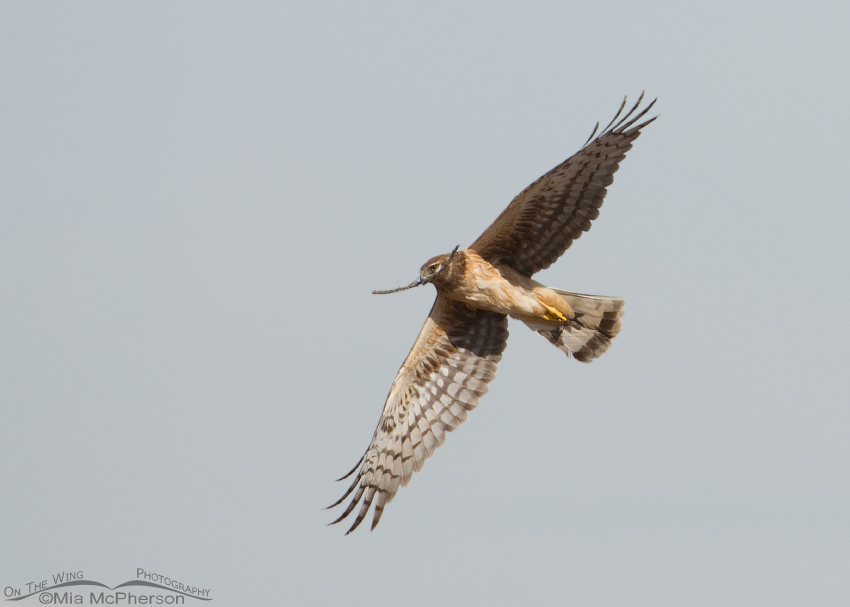 Female Northern Harrier in flight with nesting material – Nikon D200, f6.3, 1/2000, ISO 400, Nikkor 200-400mm VR with 1.4x TC at 400mm, natural light, not baited
Female Northern Harrier in flight with nesting material – Nikon D200, f6.3, 1/2000, ISO 400, Nikkor 200-400mm VR with 1.4x TC at 400mm, natural light, not baited
During the last week of April while out looking for birds to photograph in a marshy location I spotted a Northern Harrier circling in the sky, I hoped that it would come closer so I got my settings ready on my camera and aimed my lens towards the bird. When I focused on the harrier through the viewfinder I was excited to see that the female harrier had a twig in her bill, a very good sign that I was seeing and photographing a nesting Northern Harrier.
 Northern Harrier female circling with nesting material – Nikon D200, f6.3, 1/2000, ISO 400, Nikkor 200-400mm VR with 1.4x TC at 400mm, natural light, not baited
Northern Harrier female circling with nesting material – Nikon D200, f6.3, 1/2000, ISO 400, Nikkor 200-400mm VR with 1.4x TC at 400mm, natural light, not baited
The female harrier was flying in wide circling loops in the air moving closer with each circle. At times the mountains and sky showed as a backdrop in my viewfinder. Her flight seemed unhurried and her grip on the twig was good.
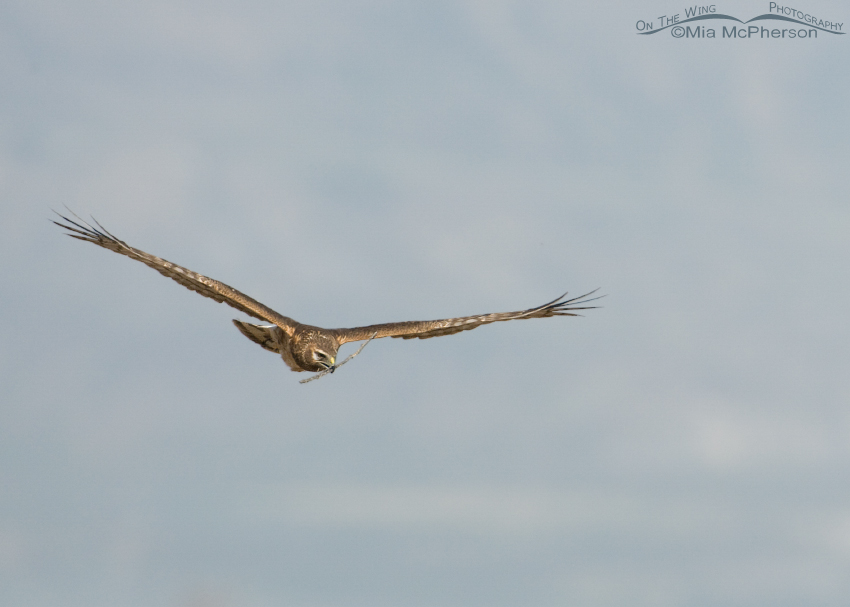 Female Northern Harrier making approach to the nest – Nikon D200, f6.3, 1/2000, ISO 400, Nikkor 200-400mm VR with 1.4x TC at 400mm, natural light, not baited
Female Northern Harrier making approach to the nest – Nikon D200, f6.3, 1/2000, ISO 400, Nikkor 200-400mm VR with 1.4x TC at 400mm, natural light, not baited
The harrier turned towards the vehicle (used as a mobile blind) and started to descend, at that point I began to wonder if the nest was nearby, I hoped that it was. I was not disappointed.
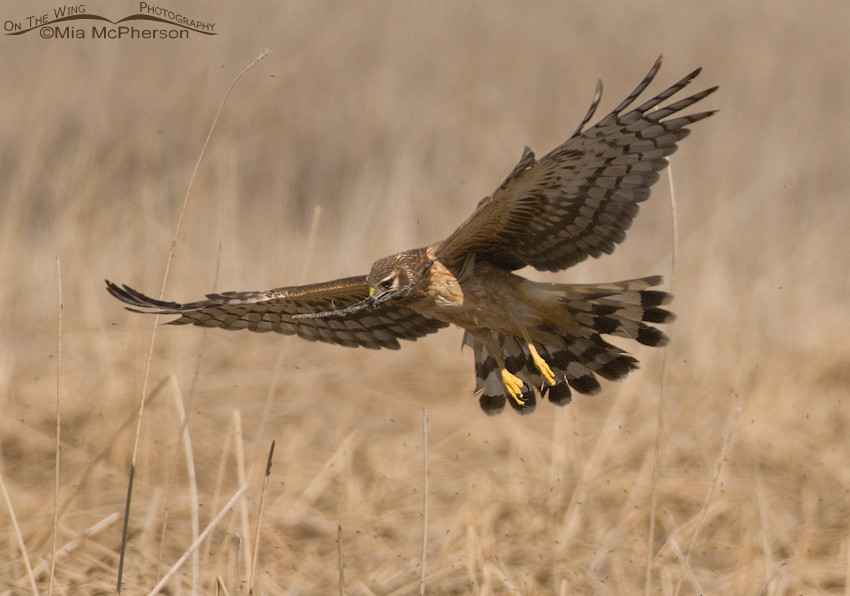 Female Northern Harrier slowing down above the nest – Nikon D200, f6.3, ISO 400, Nikkor 200-400mm VR with 1.4x TC at 400mm, natural light, not baited
Female Northern Harrier slowing down above the nest – Nikon D200, f6.3, ISO 400, Nikkor 200-400mm VR with 1.4x TC at 400mm, natural light, not baited
I remember holding my breath as the harrier flew closer and closer and quickly recognized that her wing position indicated that she was about to land. I pressed my shutter button slowly because I didn’t want to have my buffer fill and cause me to miss the shots I wanted of the harrier landing. (I’ve missed some great shots that way and I’m trying very hard not to do it again!)
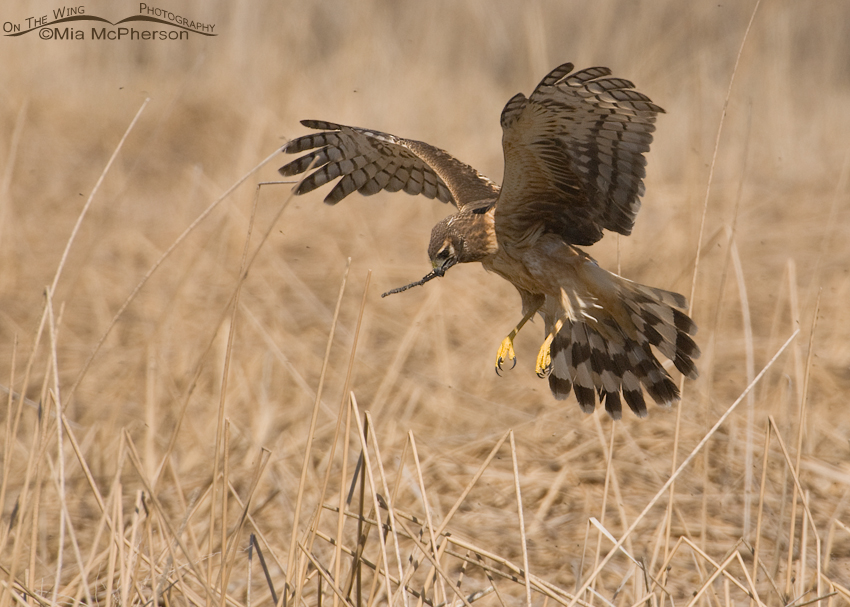 Female Northern Harrier hovering – Nikon D200, f6.3, 1/2000, ISO 400, Nikkor 200-400mm VR with 1.4x TC at 400mm, natural light, not baited
Female Northern Harrier hovering – Nikon D200, f6.3, 1/2000, ISO 400, Nikkor 200-400mm VR with 1.4x TC at 400mm, natural light, not baited
The female harrier hovered briefly, her legs moved slightly forward, her tail fanned out and she seemed focused on a particular spot in the dried vegetation that had been bent over by the heavy snow from this past winter. Looking at the similar hues of tans and browns of both the bird and the vegetation makes me realize how easily the female harriers must blend into the habitat.
 Female Northern Harrier touching down – Nikon D200, f6.3, 1/2000, ISO 400, Nikkor 200-400mm VR with 1.4x TC at 400mm, natural light, not baited
Female Northern Harrier touching down – Nikon D200, f6.3, 1/2000, ISO 400, Nikkor 200-400mm VR with 1.4x TC at 400mm, natural light, not baited
Having spotted the exact location she wanted to land the hen harrier extended her feet and appeared to grasp the dried vegetation with her talons, never taking her eyes off of where she wanted to land. By the way; the little black specks you see in the images with the dried vegetation are midges. There are often swarms of thousands of them near marshes here. I’m sure a lot of people mistake them for mosquitoes but thankfully they don’t bite like mosquitoes do. They don’t buzz like mosquitoes either. Soon enough though the mosquitoes will appear, yuck!
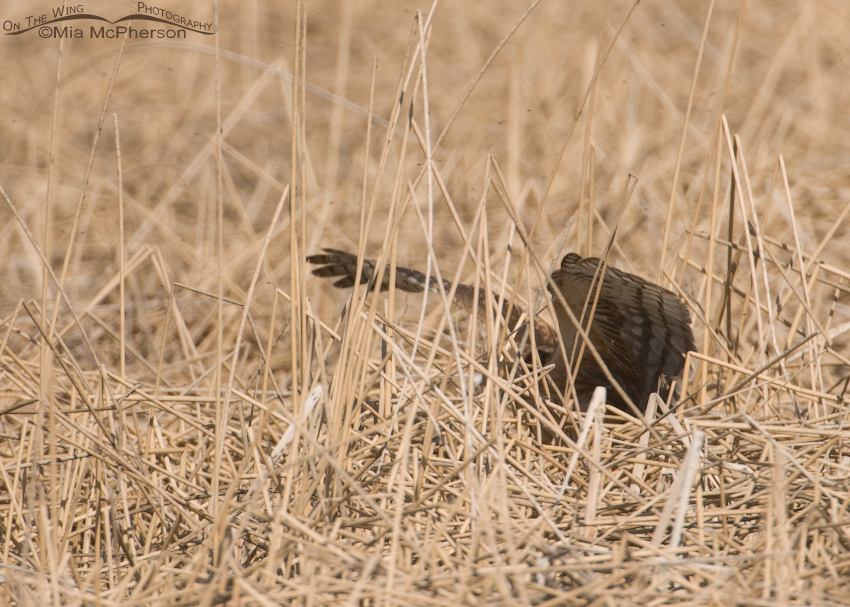 Female Northern Harrier in the nest – Nikon D200, f6.3, 1/2000, ISO 400, Nikkor 200-400mm VR with 1.4x TC at 400mm, natural light, not baited
Female Northern Harrier in the nest – Nikon D200, f6.3, 1/2000, ISO 400, Nikkor 200-400mm VR with 1.4x TC at 400mm, natural light, not baited
Very soon after the image above was taken the hen harrier disappeared from sight, even after waiting about 20 minutes she didn’t reappear. I can only imagine that she was adjusting the nesting material she brought in or perhaps taking a break from locating more nesting materials.
I was more than excited to have witnessed and photographed the female harrier bringing in that twig, it was the first time that I have ever seen a harrier building a nest. It more than made my day! Who knows… in a couple of weeks I may be able to photograph Northern Harrier chicks too.
Mia


Just seeing this sequence of events would be a treat, but to get such a nice series of photos as well is a huge plus. But you always have great shots!
Stunning photos as usual